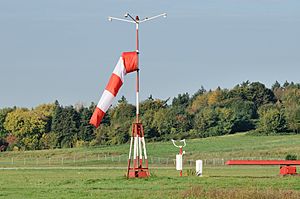Windsock facts for kids

Windsock in Germany.
|
|
| Classification | Meteorological instrument |
|---|---|
| Uses | Indicates wind direction and estimates its speed. |
| Related | Anemometer, weather vane |
A windsock (also called a wind cone or wind sleeve) is a conical textile tube that resembles a giant sock. It can be used as a basic indicator of wind speed and direction, or as decoration. They are typically used at airports to show the direction and strength of the wind to pilots, and at chemical plants where there is risk of gaseous leakage. They are also sometimes located alongside highways at windy locations.
At many airports, windsocks are externally or internally lit at night.
Function
Wind direction is the direction in which the windsock is pointing. (Wind directions are conventionally specified as the compass point from which the wind originates; so a windsock pointing due north indicates a southerly wind). Wind speed is indicated by the windsock's angle relative to the mounting pole; in low winds it droops; in high winds it flies horizontally.
Alternating stripes of high visibility orange and white were initially used to help to estimate wind speed, with each stripe adding 3 knots to the estimated speed. However, some circular frame mountings cause windsocks to be held open at one end, indicating a velocity of 3 knots even when it is not present. A fully extended windsock suggests a wind speed of 15 knots (28 km/h; 17 mph) or greater.
Standards
Per FAA standards, a properly functioning windsock orients itself to a breeze of at least 3 knots (5.6 km/h; 3.5 mph) and fully extends in wind of 15 knots (28 km/h; 17 mph).
Per Transport Canada standards, a 15 knots (28 km/h; 17 mph) wind fully extends the windsock; a 10 knots (19 km/h; 12 mph) wind raises it to 5° below the horizontal; and a 6 knots (11 km/h; 6.9 mph) wind raises it to 30° below the horizontal.
ICAO standards specify a truncated cone-shaped windsock at least 3.6 m long and 0.9 m in diameter at the large end. It should be visible and understandable from an altitude of 300 m and ideally be of a single colour. If it is necessary to use two colours, they should ideally be orange and white arranged in five alternating bands, with the first and last darker in tone. In wind speeds of 3 knots (5.6 km/h; 3.5 mph) or more they must indicate wind direction to within ±5°.
See also
 In Spanish: Manga de viento para niños
In Spanish: Manga de viento para niños
- Air sock
- Anemometer – meteorological device for measuring wind speed and direction
- Draco (military standard) - military standard carried by the Roman cavalry.
- Koinobori – Japanese decorative carp-shaped windsocks

